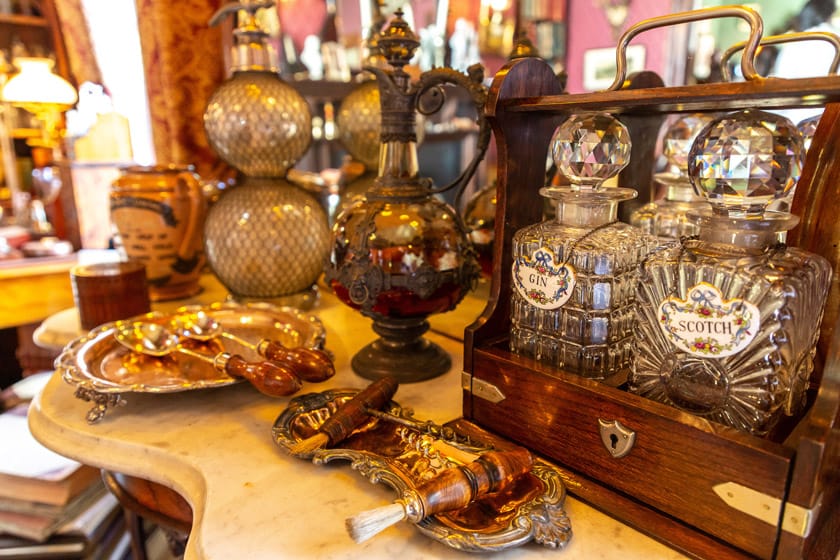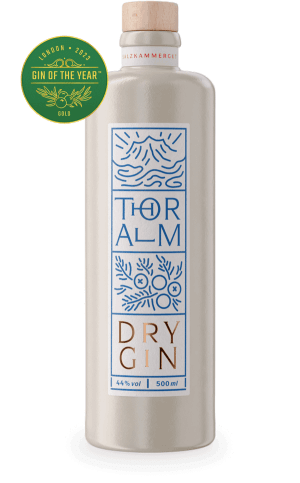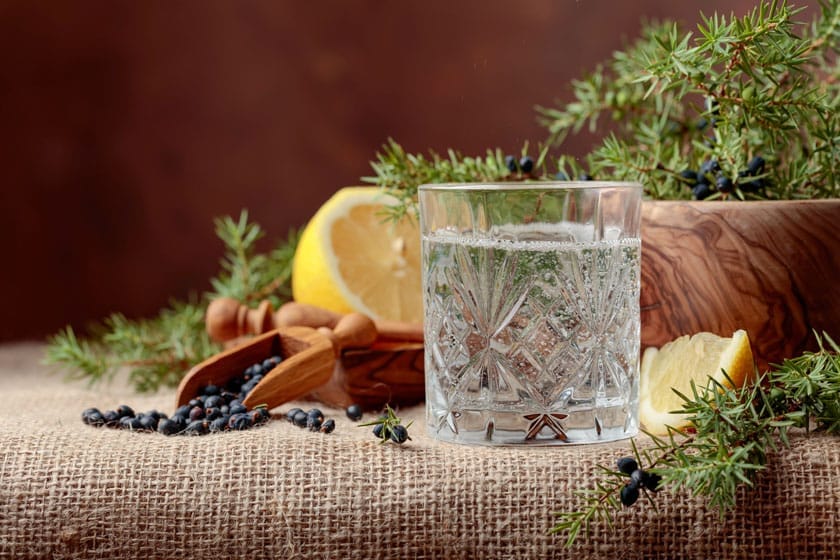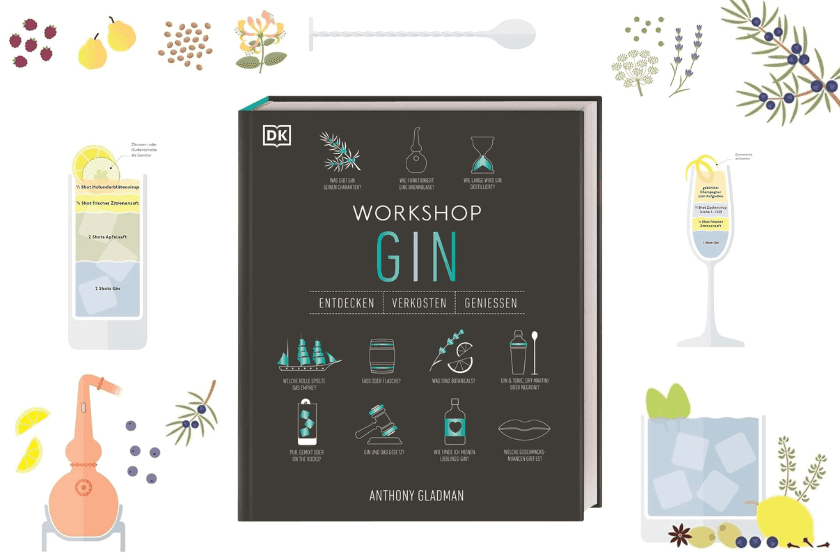Gin - a drink that was once known as a medicinal remedy, now has a permanent place in bars and bar cabinets all over the world. But how did this versatile juniper spirit develop from its medicinal origins to become one of the most popular drinks of our time? The history of gin is a fascinating journey that ranges from the alchemical experiments of medieval monks to the modern craft movement. The history of gin shows how this special spirit has changed and developed over the centuries.
The Gin Story – From Medicine to Luxury Item
The history of gin begins long before the drink received its current name and became known as an enjoyable spirit. To understand the origins of gin, we must go back to the Middle Ages, a time when the art of distillation found its way from the Arab world to Europe.
The Art of Distillation
Distillation, a process for separating and purifying liquids by evaporation and condensation, was perfected by Arab alchemists in the early Middle Ages. This technique reached Europe through trade contacts and the Crusades, where it was initially used primarily in monasteries and pharmacies. The history of gin shows that Christian monks quickly recognized the potential of distillation for producing alcoholic tinctures and extracts from medicinal plants.
Alcohol as Medicine
In medieval Europe, alcohol was an important part of medicine. Alcoholic herbal tinctures were used to treat various diseases and ailments. Many plants were considered valuable for their healing properties, including juniper, which is now known as the main ingredient in gin. Juniper berries were valued for their health benefits in ancient times. They were considered diuretic, digestive and antiseptic.
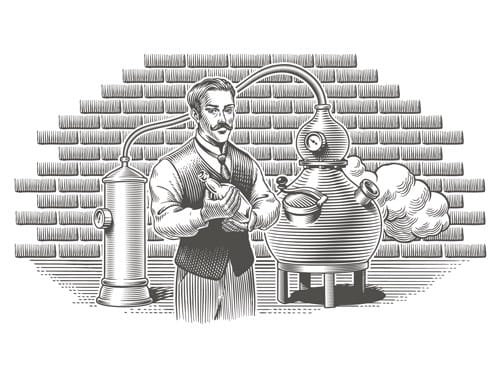
Juniper – The Medicinal Plant
The use of juniper berries as a medicinal remedy goes back a long way. Juniper berries were already used as medicine in ancient Egypt. In ancient Greece and Rome, their healing properties were valued. Dioscorides, a famous Greek doctor of the 1st century, described the medicinal use of juniper berries in his work "De materia medica". Gin history shows that juniper already played an important role back then.
In the Middle Ages, juniper again attracted attention. Juniper tinctures were used as a protective agent, especially during times of plague epidemics such as the Black Death. It was believed that the antiseptic properties of juniper could prevent the spread of the disease. People wore juniper berries as amulets and burned them in their homes to purify the air. The history of gin shows how deeply rooted the use of juniper is in European tradition.
The Birth of Juniper Distillate
The idea of distilling juniper berries arose from the desire to harness the berries' healing properties in a concentrated form. Monks and alchemists began distilling juniper berries along with other herbs and spices to create stronger and more effective remedies. These early distillates were not consumed as a luxury item, but were used exclusively for medicinal purposes.
A particularly notable example of the use of juniper distillates in medicine can be found in the Dutch Genever, the predecessor of modern gin. Genever, named after the French word for juniper, "genièvre", was developed in the 16th century by the Dutch doctor Sylvius de Bouve. He distilled the juniper berries to produce a remedy to stimulate urination and to treat gastrointestinal complaints.
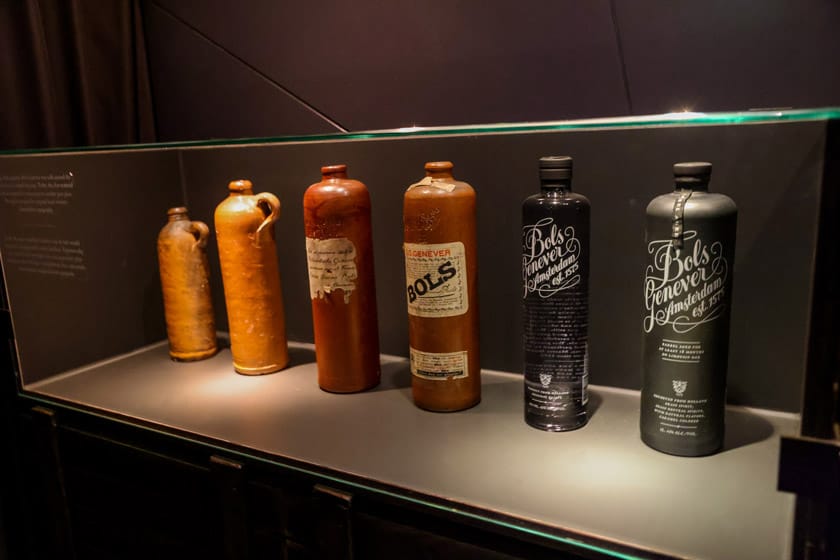
The Connection to Alchemy
The alchemical tradition played an important role in the development of distillation techniques and early alcoholic tinctures. Alchemists searched for the "elixir of life" and other miraculous remedies. This search led to numerous experiments with plants, metals and minerals. Gin history shows that distillation was a central tool in this.
The alchemical philosophy of transforming and purifying the elements was reflected in the early distillation processes. Alcohol was seen as the "water of life," capturing the essence of the plant and concentrating its healing powers. This concept led to the development of aqua vitae, the "water of life," an early form of brandy that later became the basis for various spirits, including gin. The history of gin illustrates how deeply rooted alchemical principles are in the creation of this popular drink.
Gin reaches England – From Genever to Gin
The history of gin in England begins in the 17th century, when British soldiers brought genever from the Netherlands during the Dutch-Spanish War. Genever, a juniper-flavored liquor, was known to Dutch troops as "Dutch Courage" because it was said to give them courage in battle. The English soldiers not only adopted the drink, but also a preference for its taste and invigorating effect. Back home, genever quickly spread and was given the more catchy name "gin."
Wilhelm III and the Promotion of Gin
A crucial turning point in the history of gin was the ascension of William III of Orange-Nassau to the English throne in 1689. William, a Dutchman, brought with him not only his political and military experience but also his love of genever. Under his rule, the production of gin was greatly promoted. This was done through a series of economic and political measures:
- Taxation of French spirits: William III imposed heavy taxes on imported French spirits to reduce consumption of these beverages and dependence on France. This created a gap in the market that domestic gin was able to fill.
- Tax exemption for gin: At the same time, William made the production of gin tax-free, which led to the establishment of numerous distilleries and gin becoming a cheap and easily available drink.
These measures promoted the rapid spread and popularity of gin in England. Within a very short time, gin became an integral part of English drinking culture.
The Gin Craze in England – Rise and Fall
In the 18th century, England experienced an unprecedented gin mania, which was "Gin Craze" The popularity of gin grew rapidly and the city of London became the center of this new drinking culture. But the rapid rise of gin also brought with it considerable problems.
Excessive consumption and social problems
Gin consumption became so rampant that it caused serious social problems. The reason for this was the cheap and mass production of gin, which often came at the expense of quality. Distilleries used inferior ingredients and diluted their gin with dangerous additives such as turpentine, sulphuric acid and sugar to mask the bad taste. This led to a shockingly high number of alcoholics, an increase in crime and violence and a general brutalisation of society.
The effects of excessive gin consumption were devastating:
- High crime rates: The increasing number of drunken and impoverished people led to an increase in thefts, robberies and other crimes.
- Health problems: Consumption of low-quality gin resulted in serious health damage, including alcohol poisoning and long-term illness.
- Social neglect: Families broke up and the overall quality of life declined, while mortality rates rose and birth rates fell.
The devastating conditions were depicted in William Hogarth’s famous painting "Gin Lane" which impressively depicts the dark side of gin mania.
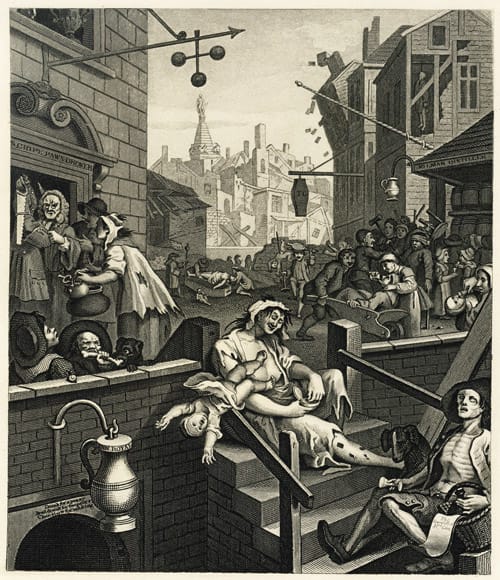
The Gin Acts – Legal Measures for Regulation
In order to curb the uncontrolled spread and excessive consumption of gin, the British government passed a series of laws known as "Gin Acts" Between 1729 and 1751, a total of eight Gin Acts were passed, aimed at regulating and controlling the production and sale of gin:
- Gin Act of 1729: Introduction of licenses for distilleries and restrictions on the sale of gin.
- Gin Act of 1736: Drastic increase in taxes on gin and the introduction of high licensing fees for serving gin.
- Gin Act of 1751 (Tippling Act): Tightened measures to control gin production and sales. The quality of gin was more strictly monitored and penalties for producing and selling substandard gin were increased.
These measures gradually had an effect. The quality of gin improved, prices rose and consumption decreased. The population began to recover from excessive drinking habits and gin gradually lost its reputation as a "poor man's brandy".
The Path of Gin into the Upper Class
With improved quality and stricter regulations, gin regained its popularity in the 19th century, but this time in higher circles. Old Tom Gin, a sweetened version, was particularly popular with the female population. The London Dry Gin, which was produced in the renowned distilleries of London and Finsbury, established itself as a high-quality spirit and conquered the hearts of the upper class. Gin was now enjoyed with pointed fingers from fine glasses and became a symbol of sophisticated drinking culture.
Gin Tonic – A British Classic
The Gin Tonic, a classic that is still popular around the world today, was invented in India. British soldiers stationed in the colony mixed gin with tonic water containing quinine to protect themselves from malaria. The bitter tonic water was made more palatable by the gin and thus the iconic long drink was born.
Gin in Prohibition
American Prohibition from 1920 to 1933 marked a period when the manufacture, sale and transportation of alcoholic beverages were prohibited in the United States. This prohibition posed an immense challenge to the alcohol industry, but at the same time opened up new opportunities for the illegal trade and the creativity of bootleggers and bartenders.
Smuggling and creative solutions
During Prohibition, gin was smuggled into America illegally, often across the Canadian border or by sea. This happened not only from England, but also from the Netherlands and other European countries, where genever and other gin variants continued to be produced. The smuggled gin was often of inferior quality, as it was produced in improvised distilleries that did not have the same standards as the established distilleries in Europe.
To mask the bad taste of this so-called “bathtub gin”, bartenders and smugglers invented numerous cocktails. These mixed drinks became a way to make the taste of bad gin bearable and at the same time satisfy the demand for alcoholic beverages. Some of the most famous cocktails that emerged during this time are the Gin Fizz, the Martini and the GimletThese cocktails used various ingredients such as citrus fruits, sugar and herbs to enhance the taste of the gin and provide a pleasant drinking experience.
Gin after the World Wars – A Decline in Popularity
After the end of Prohibition and the two World Wars, the alcohol industry underwent a transformation. During the 1940s and 1950s, other spirits such as vodka and rum became increasingly popular, causing gin to fall into obscurity. Gin's history shows how consumers were looking for new taste experiences, and vodka was particularly valued for its neutral taste and versatility in cocktails.
The shift in drinking habits was also influenced by the changing social and cultural landscapes after the war years. The glamour of Hollywood and the emerging cocktail culture of the 1950s and 1960s brought vodka martinis and rum cocktails into fashion, while gin was increasingly seen as old-fashioned and outdated. The history of gin illustrates how societal changes influenced the popularity of different spirits.
The Renaissance of Gin – Rediscovery and Innovation
In recent decades, gin has experienced a remarkable renaissance, closely linked to the emerging craft movement in the spirits industry. This movement emphasizes artisanal production processes, high-quality ingredients and innovative flavors. Small distilleries around the world began to produce experimental and high-quality gins that clearly stood out from the mass products of the large manufacturers.
Botanicals and new flavor profiles
A key aspect of the modern gin renaissance is the variety of ingredients used. botanicals. Traditionally, gin is made primarily from juniper berries, but new craft gin producers expanded the flavor profile by adding a variety of herbs, spices, fruits and flowers. These botanicals give gin unique flavors and make it an extremely versatile spirit that is great for various cocktails.
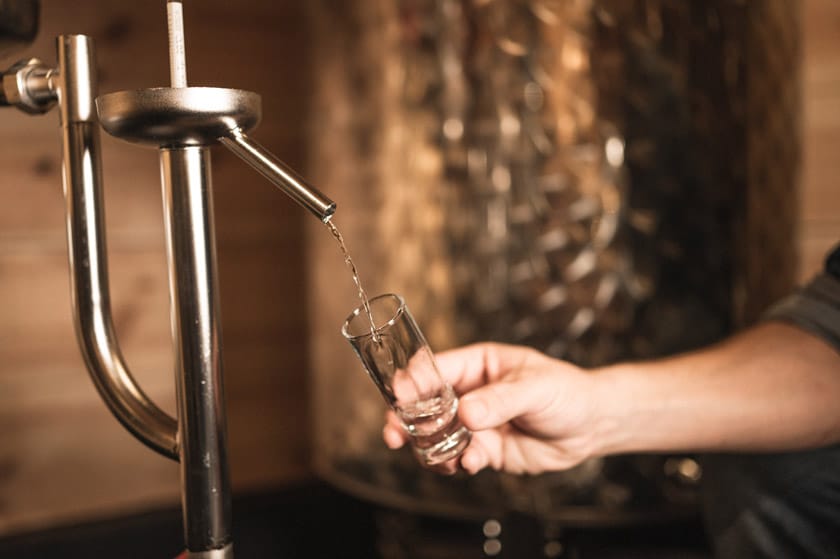
gin bars and mixology
Parallel to the craft movement, the culture of gin bars and mixology. gin tasting events, specialised gin bars and the creative use of gin in modern cocktails have helped to renew the image of gin and bring it back into the focus of connoisseurs. Bartenders around the world are experimenting with new recipes and techniques to create the perfect gin cocktail, further fuelling gin's popularity.
New trends and variants
In addition to the classic London Dry Gin Other variants such as flavored gin and Aged Gin established. Flavoured gin, which is enriched with various fruit or spice flavours, appeals to a wider audience and opens up new possibilities for cocktails. Aged gin, which is stored in wooden barrels, gains complexity and depth and offers an interesting alternative to traditional gins.
The Role of Gin Manufacturers
Gin manufacturers like ours are making a significant contribution to the rediscovery and further development of gin. By combining traditional distillation methods with modern innovations, we create a unique product that embodies the spirit of the craft movement. Our carefully crafted THORALM Gin offers an exceptional taste profile and invites you to rediscover the world of gin.
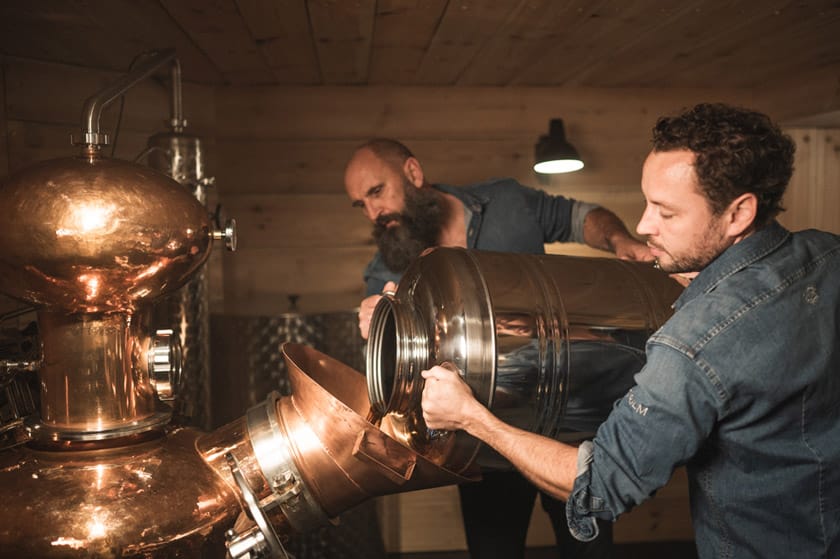
Conclusion
The history of gin is a fascinating journey from its medicinal beginnings through its excessive popularity in the 18th century, the challenges of prohibition and the modern Renaissance. The history of gin shows how this remarkable juniper liquor has developed and is enjoying great popularity again today, thanks to the creativity and craftsmanship of small distilleries and the growing enthusiasm for high-quality, versatile spirits.
At our gin factory THORALM, we continue this tradition by producing a high-quality, innovative gin that honors both the history and the future of this remarkable spirit. Our commitment to quality and innovation is reflected in every drop, offering a unique taste experience that combines both tradition and modernity.
-

DRY GIN in gift box 500ml
72,00 €14,40 € / 100 ml
incl. 20% VAT
plus shipping costs
Product contains: 500 ml
Add to cart -

THORALM DRY GIN 500ml
59,90 €11,98 € / 100 ml
incl. 20% VAT
plus shipping costs
Product contains: 500 ml
Add to cart -

THORALM DRY GIN 6 x 500ml
339,40 €11,31 € / 100 ml
incl. 20% VAT
plus shipping costs
Product contains: 3000 ml
Add to cart
Photos: THORALM; stock.adobe.com
